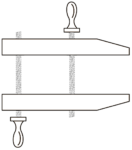Trees get sick, just like other living things. A partial list of important North American tree diseases includes, in order of severity: Emerald Ash Borer, Dutch Elm Disease, White Pine Blister Rust, Armillaria Root Rot, Anthracnose Leaf Spot Disease. Each of these diseases affects one or more species and is caused by a specific, usually fungal, pathogen.
Chestnut Blight exceeds all the others in economic and ecological impact and magnitude of destruction in the U.S. After the end of the last ice age and before European colonists arrived on our shores hardwood forests covered 32.4 million acres (50,607 sq. miles) from Maine to Alabama and west to the Ohio valley. One in every four trees in this eastern forest was an American chestnut. It was said that a squirrel could travel the canopy from Maine to Georgia without touching the ground.

Chestnuts were an important food source for native Americans as well as large and small mammals, birds (including the Passenger Pigeon) and innumerable benign insects. Unlike acorns chestnuts do not require boiling to be edible. The chestnut tree's exceptional height, straight grain, workability and great rot resistance made its lumber ideal for home building, fences and, eventually, railroad ties and telegraph poles. Less attractive than walnut or cherry, it was a common substrate for veneer in furniture making. The American chestnut blooms perennially. Nuts were so plentiful they could be harvested by the shovel full, a valuable cash crop for livestock feed. The lumber was vital to local economies, especially in Southern Appalachia. Wood chips provided tannin for the tanning industry and could then be used to make paper. Chestnut leaves, unlike oak, were nourishing to some animals. The rapid decay of leaves and nuts added beneficial nutrients to soils and aquatic environments.
There are at least seven species of Chestnut. The American Chestnut, Castenea dentata, is closely related to the European Chestnut, C. sativa – also susceptible to the blight. But the tree in Longfellow's famous poem, The Village Blacksmith, (“Under a spreading chestnut tree…..”), was actually a Horse chestnut; an entirely different genus.
In 1876, S. B. Parsons, a New York nurseryman, imported some Japanese chestnut trees and sold them as a popular, exotic garden tree. Luther Burbank planted a box of seeds from Japan in 1886 and soon had thousands growing in his California nursery. Some of these trees were infected with a fungus, Cryphonectria parasitica. Asian chestnut tress, especially the Chinese species, had evolved resistance to this pathogen but it rapidly kills the American species. Carried in rain water or by wind and on birds or squirrels, the fungus quickly became established in North America.
This exceptionally lethal infection occurs when spores land on tree bark and enter through insect wounds. Spores germinate rapidly and create cankers which spread around the tree, eventually clogging the vessels which transport water to limbs and leaves.
Chestnut Blight was first recognized in 1904 by Hermann Merkel, forester at the New York Zoological Park (The Bronx Zoo today). By the next Spring nearly every tree in the park was infected. Spreading at the rate of 24 miles per year, blight killed nearly four billion trees over the next 50 years. Chestnut roots are resistant to the fungus, allowing new shoots grow from root systems or stumps and survive for a while. But these saplings die before becoming mature enough to flower and produce nuts.
Some mature American chestnut trees still survive; a few dozen trees in Maine, where a healthy 95′ tall tree was found in 2016, probably the largest specimen in the U.S. A small grove descended from eight trees planted many years ago grows on private land near West Salem, Wisconsin, originally saved because of its distance from the eastern forests. It was the largest remaining healthy stand of American chestnut trees until 1980 when it was found to be infected. Currently about five thousand of the original West Salem trees survive in various states of health.
There are ongoing attempts to resurrect the American chestnut. Individual trees have both male and female blossoms but can not self pollinate. To produce fruit, pollen from one tree must pollinate blossoms on another tree. This makes crossbreeding difficult and requires decades to produce results. Arthur Graves, a Yale trained botanist, began crossing surviving C. dentata trees with various Asian species in 1931, creating 250 different combinations over the next 30 years – without producing a satisfactory hybrid. A parallel program run by the USDA produced one healthy, 30 ft. tree by 1959 (the Clapper Tree). It became infected about 10 years later and died in 1976.
James Carpenter, of Salem, Ohio, found a huge, healthy American chestnut in a grove filled with dead and diseased trees in 1950. After failing to infect this tree with the fungus, he sent bud wood to plant breeder Dr. Robert Dunstan who grafted these scions onto chestnut rootstocks. They grew well and were crossed with USDA released Chinese chestnut species. Seedlings from the first cross began to bear in 1962. Trees with the best hybrid characteristics were crossed in repeated generations back to American and Chinese parent trees. The patented Dunstan Chestnut tree is advertised for sale online for $24.95 and is said to bear fruit in 2-4 years, producing 10-20 pounds of nuts in 10 years. There has been no independent verification of these results.
Although hybrid trees do not possess all the desirable qualities of American chestnuts, genetic engineering holds promise for restoring the American Chestnut. But the few genes responsible for resistance have been identified. By inserting genes from wheat, Asian chestnuts, grapes, peppers and other plants into American chestnut trees, William Powell from SUNY–ESF has created transgenic trees almost 100% genetically identical to the American chestnut, yet immune to C. parasitica. For more details, go to:
https://phys.org/news/2016-01-genetically-american-chestnut-decimated-iconic.html
In the 1930s blight reached Europe. Years later an Italian scientist found trees in Italy which seemed to show evidence of spontaneous recovery. In 1965 this observation led Jean Grente, a French agronomist, to identify a virus which attacks and kills the C. parasitica fungus. This process, called hypovirulence, protects trees. Sick trees, when infected with the virus-containing fungus, showed significant recovery. A similar virus, that arose naturally, was found in a small grove of chestnut trees in Rockford, Michigan in 1976. Sadly, genetic diversity in both the fungus and the virus renders hypovirulence ineffective in producing lasting, widespread resistance. An experiment deliberately inoculating trees with the virus in the West Salem, Wisconsin forest was unsuccessful.
Dire threats continue to endanger our forests. Closer to home Sudden Oak Death (also present in Europe, origin uncertain, discovered in 1995) produces scenes like this in California.

In San Diego County and northern California, Pine Bark Beetle infestation has destroyed millions of acres of pine forest. This beetle is native to North America but has flourished because of the long standing drought and warming climate.
A complete survey of Chestnut blight is available in Susan Freinkel's excellent book, American Chestnut, available at the public library. For a detailed list of tree pathogens, search “tree pathogens” at this site:
By Dick Ugoretz (originally published on March 2017)
Editor's Note: Light edits have been made to remove broken web links.






